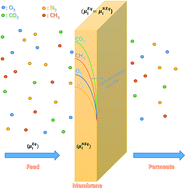A predictive model for gas and vapor sorption into glassy membranes at high pressure
Abstract
This work focuses on the development of a predictive model based on the non-equilibrium lattice fluid (NELF) model using the fractional free volume (FFV) for the gas and vapor sorption into glassy membranes in a large interval of pressure and temperature. For this purpose, the FFV values were calculated as a function of pressure and temperature and the NELF model was modified in terms of the FFV. The proposed model was validated with the experimental data for the sorption of various gases and vapors in the glassy membranes including polysulfone (PSf), bisphenol chloral polycarbonate (BCPC), polystyrene (PS), polycarbonate (PC), poly(methyl methacrylate) (PMMA), poly(1-(trimethylsilyl)-1-propyne) (PTMSP) and polyphenylene oxide (PPO). A very good agreement was observed between the predicted results and the experimental data for the sorption of Ar, O2, N2, CO2 and CH4 into the glassy membranes. The developed model enables predicting the effect of pressure and temperature as well as the gas critical temperature on the gas sorption into the glassy membranes without need for any adjustable parameters. A linear trend between the logarithm of gas solubility and penetrant critical temperature was observed. Furthermore, the solubility data of the organic vapors and gas mixtures in the glassy membranes were successfully predicted by the modified NELF model.


 Please wait while we load your content...
Please wait while we load your content...